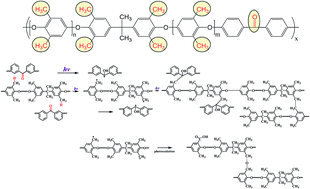Gas transport properties and characterization of UV crosslinked poly(phenylene oxide-co-arylene ether ketone) copolymers
Abstract
Poly(phenylene oxide-co-arylene ether ketone) and poly(phenylene oxide-co-arylene ether ketone ketone) copolymers were prepared by polycondensation of a dihydroxyfunctional poly(2,6-dimethylphenylene oxide) oligomer with 4,4′-difluorobenzophenone or 1,3-bis(4-fluorobenzoyl)benzene and their properties were compared to a homopolymer from 2,2-bis(4-hydroxy-3,5-dimethylphenyl)propane (tetramethylbisphenol A, TMBPA) and difluorobenzophenone. The polymers were cast into films, then crosslinked in the solid state with UV light with the wavelength of 365 nm at room temperature to form asymmetrically crosslinked thermoset membranes with high gel fractions. This approach offers a means for fabricating membrane films, fibers or composites, as well as tuning of gas transport properties through crosslinking in the solid state. Structural analysis via NMR, IR, and UV-vis spectroscopy confirmed the expected copolymer compositions and provided support for a free radical crosslinking reaction involving coupling between the aromatic ketone and labile benzylic methyl groups. Introduction of the ketone group resulted in a decrease in permeabilities, but an increase in selectivities for O2/N2 and CO2/CH4 gas pairs over unmodified PPO. Additionally upon crosslinking a large shift was observed in the gas properties of all the membranes, with permeability decreasing and the selectivity increasing for the O2/N2 and CO2/CH4 gas pairs.



 Please wait while we load your content...
Please wait while we load your content...